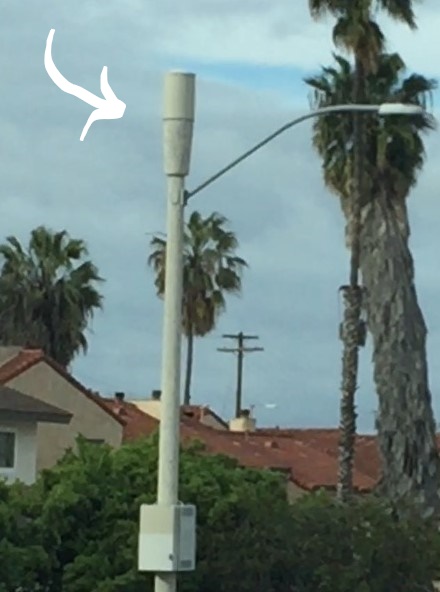 San Diego’s County Board of Supervisors (BOS) voted on August 7th, 2019, for an amended County staff version of a new 5G small cell wireless ordinance for the unincorporated part of San Diego County. This ordinance, as amended at the meeting, allows industry essentially what it would like, though many administrative requirements accomplished in this ordinance were seen by industry as deterrants and objected to in the final proceeding. However, from the concerned residents’ standpoint, there were no residential setbacks from small cells at all, despite hundreds of letters requesting this and scientific evidence of need for distance between small cells and living beings. At Chairperson and Supervisor Dianne Jacob’s motion, a 1000 foot setback for schools was changed to 300 ft setbacks to please industry which had lobbied for this. No protections whatsoever were adopted for distances between existing street poles, where small cells will be placed. No protection for disabled persons who must avoid rf radiation at close range. A 1000 foot distance between new poles was kept in the ordinance, as far as we know, with co-location of small cells allowed (double the radiation). Staff (including County Counsel) led the Supervisors to believe that they could not have setbacks. So how is it that at least 20 municipalities in CA that County residents presented have these? Does no one check on what staff is saying? Who is running the County and better yet, why is the truth missing on life and death issues like this one?
San Diego’s County Board of Supervisors (BOS) voted on August 7th, 2019, for an amended County staff version of a new 5G small cell wireless ordinance for the unincorporated part of San Diego County. This ordinance, as amended at the meeting, allows industry essentially what it would like, though many administrative requirements accomplished in this ordinance were seen by industry as deterrants and objected to in the final proceeding. However, from the concerned residents’ standpoint, there were no residential setbacks from small cells at all, despite hundreds of letters requesting this and scientific evidence of need for distance between small cells and living beings. At Chairperson and Supervisor Dianne Jacob’s motion, a 1000 foot setback for schools was changed to 300 ft setbacks to please industry which had lobbied for this. No protections whatsoever were adopted for distances between existing street poles, where small cells will be placed. No protection for disabled persons who must avoid rf radiation at close range. A 1000 foot distance between new poles was kept in the ordinance, as far as we know, with co-location of small cells allowed (double the radiation). Staff (including County Counsel) led the Supervisors to believe that they could not have setbacks. So how is it that at least 20 municipalities in CA that County residents presented have these? Does no one check on what staff is saying? Who is running the County and better yet, why is the truth missing on life and death issues like this one?
The ole “our hands are tied” excuse was given repeatedly. Here is a sympathetic version of the meeting as written in the Rancho Santa Fe Review (which did not explain how it was that OTHER municipalities’ hands weren’t tied). When the issue is life and death, that excuse doesn’t wash!
Here is a more critical version of the meeting, as seen in the East County Magazine:
READER’S EDITORIAL: SUPERVISORS’ APPROVAL OF 4G / 5G ORDINANCE WITH NO SETBACK FROM HOMES FAVORS INDUSTRY OVER RESIDENTS
More from the San Diego County website on Small Cell Wireless Facilities
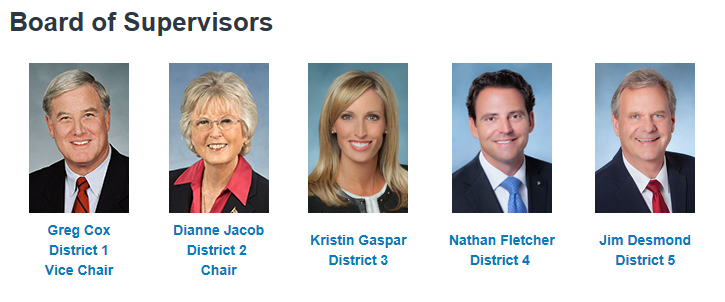
Supervisors ignore pleas of constituents to protect them from 5G small cells. Hundreds of letters flowed into their offices against 5G; several protest rallies were held, and at least 50 people testified against 5G on four occasions during this 7 month process.
See the letters many sent below, in documents (public communications), and herein.
County lawyers advised with what appears to be questionable information on whether the County could require telecoms to test annually and pay for County hiring 3rd parties to test rf emissions to be sure they are in alignment with FCC guidelines. Otherwise it is self-reporting and only done at the start of the permit, not annually. The atty said that could not be allowed because it would be “based on health”. County residents working with the County staff to frame this wireless ordinance wanted testing every year to ensure safety. The reason for the FCC guidelines is to protect from tissue heating and thermal burns from rf radiation when it exceeds a certain amount.
Section 704 of the Telecommunications Act of 1996 says:
`(iv) No State or local government or instrumentality thereof may regulate the placement, construction, and modification of personal wireless service facilities on the basis of the environmental effects of radio frequency emissions to the extent that such facilities comply with the Commission’s regulations concerning such emissions.
SO HOW CAN MAKING SURE THE TELECOMS ARE COMPLYING BE ILLEGAL? IT DOESN’T SAY, “BASED ON SELF-REPORTING” IN THE LAW ABOVE.
FURTHER, MANY OTHER MUNICIPALITIES ARE PROVIDING RESIDENTIAL AND SCHOOL SETBACKS FOR THEIR COMMUNITIES. THESE CAN BE JUSTIFIED BASED ON AESTHETICS, TECHNICALLY. But the San Diego County Board of Supervisors, despite expressing angst when they voted to crucify the entire county, did it eagerly, because they allowed it to happen and already had made up their minds, with a written statement by Supervisor Jacob being read and it passed unanimously.
Through the hard work and insistence of several community groups working with County planners despite heavy Industry sympathies on the part of the County, it appears that we did gain the following, in part (though carved up and minimized by County and Industry attorneys) in the approved SD County small cell wireless ordinance of Aug. 7th, 2019, effective Sept. 6, 2019:
GAINED
1.) Expanded ADA language though not perfect – ideally, should provide a process whereby sensitive individuals with disabilities and medical conditions who must avoid increased exposure to rf radiation may apply for and receive ADA accommodations such that small cells are not placed within a certain radius of their home or very nearby.
“12. SCWs on new and related structures shall not impair pedestrian use of sidewalks or pathways, shall be designed and sited in compliance with all Americans with Disabilities Act (ADA) accessibility requirements, and shall not inhibit equestrian activities on designated public or private trail systems. 13. All SCWs shall be built in compliance with the Americans with Disabilities Act (ADA).” (p. B-1-12)
2.) Undergrounding – TBD how helpful; is a deterrant and reduces clutter.
“15. Undergrounding. With the exception of antennas, electrical meters, and any other equipment that must be placed above ground to function, all SCW equipment must be undergrounded unless the applicant can demonstrate that undergrounding is technically infeasible.” (B-1-13)
3.) Setback for schools, childcare centers, hospitals, religious facilities, fire dept, police, etc. HOWEVER cutback to 300 ft. (cut back from 1000 feet).
“3. In order to reduce clutter and maintain the aesthetic quality and community character of
certain civic and community uses, SCWs in the right-of-way shall not be located within 300 feet [1000 feet removed by Sprvsr Dianne Jacob to please industry] of schools, child care centers, hospitals, or religious facilities [Jacob added fire and police stations at the request of another community group] unless the applicant demonstrates that compliance with this requirement would be technically infeasible. Distance, without regard to intervening structures, shall be a straight line measured from the
closest property lines.” (B-1-11)
4.) Preferred-non-preferred areas (but no incentives?). Residential is non-preferred.
5.) Insurance required (but not for harm from rf, general policy)
6.) If FCC orders overturned small cells approved under it must be deactivated within one month and removed in 12 mos. [why 12 months?]
“C. Any permit issued under this section is subject to the validity of the FCC Declaratory Ruling and Third Report and Order adopted September 26, 2018 (FCC 18-133). All SCWs shall be deactivated within 30 days from the date the FCC Ruling is repealed or overturned and shall be removed within 12 months.” (p. B-1-15)
7.) Distance between small cells on poles 1000 feet for new poles in least preferred and 500 feet in most preferred locations (changed from for any poles, existing or new).
8.) Configuration preferences (from pages B-1-11 and B-1-12)
“7. Configuration. To better assist applicants, minimize clutter, and limit other impacts to
aesthetics and community character, subsection A.8. below sets out listed preferences for
B-1-11
ATTACHMENT B-1
configurations of SCWs. Applications that involve configurations in subsections 8.i.4., 8.i.5.,
or 8.i.6. may be approved so long as the applicant demonstrates either: 1) no preferred
configurations in subsection 2.i.1. or subsection 2.i.2. exist within 1,000 feet from the
proposed site; or 2) any available structures in subsections 8.i.1., 8.i.2., or 8.i.3. within 1,000
feet from the proposed site would be technically infeasible.”
“Configuration Preferences.
i. Wherever possible, a SCW shall be installed in one of the following configurations,
ordered from most to least preferred.
1. Co-location with an existing facility
2. Existing or replacement utility poles
3. Existing or replacement structure, or roof-mounted in Industrial &
Commercial Zones only
4. County-owned street light poles
5. County-owned traffic signals
6. New utility poles
ii. SCWs shall not be placed on decorative poles.
iii. SCWs permitted on existing structures shall be co-located where possible, provided,
however, that no more than two (2) SCWs shall be co-located on the same structure.
SCWs shall be constructed and sited to accommodate the future co-location of up
to one (1) additional facilities.”
9.) No small cells on decorative poles. (Industry complained.)
10.) No more than two co-located small cells on poles. (One per pole was desired, however, by one of the community groups. Some municipalities approve 4 to a pole. Note: each small cell and accessories weigh 90 lbs according to industry reps.)
11.) Height restrictions TBD
“14. Height: i. When a SCW is attached or mounted on a structure, the least restrictive of the following height requirements shall apply: 1. The combined height of the structure and SCW shall not exceed 50 feet (including antennas). 2. The combined height of the structure and SCW can be no more than 10 percent greater in height than other structures located within 100 feet. 3. The combined height of the structure and SCW shall not increase the height of the original structure by more than 10 percent.
ii. Any SCW shall not increase the height of an existing facility.” (p. B-1-14)
12.) Plant disturbance TBD [Community group strongly requested this to save trees from being severely trimmed or removed.)
” Plant Disturbance. The applicant shall avoid disturbance to the natural landscape and existing vegetation. All vegetation disturbed during project construction shall be replanted with compatible vegetation and soils disturbed by development shall be reseeded to control erosion. ”
13.) Warning signage with info on rf emissions and owners.
“4. Signage. SCWs must include signage that accurately identifies the site owner or operator, the owner or operator’s site name or identification number and a toll-free number to the owner or operator’s network operations center. Signage must also include information advising of the nature of the potential hazard (e.g. RF emissions) and how to avoid the potential hazard. SCWs may not bear any other signage or advertisements unless expressly approved by the County, required by law or recommended under Federal Communications Commission (FCC), Occupational Safety and Health Administration (B-1-13)
ATTACHMENT B-1
(OSHA) or other United States governmental agencies for compliance with RF emissions regulations. Signs shall be no smaller than 4 inches wide and 6 inches tall and no larger than 18 inches wideand 24 inches tall, be mounted at least 10 feet above the ground to not impair pedestrian and equestrian use of sidewalks or pathways, and not conflict with other standard colors in the road right-of-way such as orange, fluorescent green, and red in orderto not create a visual distraction for drivers.”
14.) Compliance with laws
“5. Compliance with Law. All SCWs must be designed and sited in compliance with all applicable federal, state and local laws, regulations, rules, restrictions and conditions, which includes without limitation the California Building Standards Code, General Plan and any applicable specific plan, the County of San Diego Administrative Code and Regulatory Code, the Federal Communications Commission Rules and Regulations, and any conditions or restrictions in any permit or other governmental approving issued by any public agency with jurisdiction over the facility.”
15.) Grounds for removal if not continuously compliant.
” 6. Continuous Compliance. Wireless communications service providers and their operational SCWs must comply at all times with conditions of approval, this code, and all other applicable standards and laws. Failure to comply with a condition, standard or law is grounds for possible revocation pursuant to this code.”
16.) FCC Limits not exceeded. [Note: self-certification of industry is being accepted by County, however.]
“7. All SCW installations shall be physically installed and aligned so as to ensure that FCC Limits for Maximum Permissible Exposure (MPE) for radiofrequencies(RF)are not exceeded, per 47 C.F.R. § 1.1310.”
17.) add’l Removal terms.
18.) Permit application contents includes rf emissions info by licensed engineer; structural pole evaluation; written authorization by owner; scope of work TBD
“All SCW application requirements listed below shall be evaluated and signed by one or more of the following, if applicable: Licensed Architect, Licensed Contractor, Licensed Engineer, and/or Licensed Surveyor. 1. Scope of Work: Applicant shall submit a scope of work with sufficient detail to determine compliance with the requirements set forth below. 2. Structural Evaluation: Applicant shall submit a structural pole evaluation completed by a Licensed Civil Engineer or Licensed Contractor prior to placing a SCW on any County-owned utility pole, street light, or traffic signal. 3. Site Agreement: Applicant shall submit a written authorization signed by the structure owner authorizing the applicant to place a SCW on the structure.
B-1-14
ATTACHMENT B-1
4. Traffic Control Plan: Applicant shall submit a traffic control plan completed by a Licensed Civil Engineer or Licensed Contractor prior to installing an aboveground SCW on any County-maintained road. 5. Environmental Review Questionnaire: Applicant shall submit a completed environmental review questionnaire completed by a Licensed Civil Engineer or Licensed Contractor prior to installing an aboveground SCW on any County-maintained road. 6. Fire Service:Applicant shall submit evidence of compliance with Fire Policy FP-2 or a service letter from the applicable fire district. 7. RF Emissions: Applicants shall submit a radiofrequency radiation study (prepared by a licensed engineer qualitied to evaluate radiofrequency emissions) which estimates the proposed project’s radiofrequency emissions, demonstrating compliance of the proposed facility with applicable FCC policies, standards, and guidelines for MPE to radiofrequency radiation emissions. [CEP Note: an estimate is not sufficient.]
8. Notice: Any application for a new or co-located SCW shall include evidence of compliance with the following notice requirements:
i. A notice of intent to request a permit for a new SCW shall be provided to all property owners within 500 feet of the proposed facility within 10 days of the submittal of a request.
ii. A notice of intent to request a permit for a new SCW shall be provided to any applicable community planning or sponsor group where the proposed facility within 10 days of the submittal of a request.
19.) Noticing of residents within 500 feet.
“8. Notice:Any application for a new or co-located SCW shall include evidence of compliance with the following notice requirements: i. A notice of intent to request a permit for a new SCW shall be provided to all property owners within 500 feet of the proposed facility within 10 days of the submittal of a request. ii. A notice of intent to request a permit for a new SCW shall be provided to any applicable community planning or sponsor group where the proposed facility within 10 days of the submittal of a request.” (p. B-1-15)
20.) Noise – this might not cover ringing sounds of high frequencies but would cover buzzing. Don’t like the average hourly basis part.
“2. Noise. Noise from any equipment supporting the SCW shall meet the requirements of the County’s Noise Ordinance on an average hourly basis.”
21.) Receipt of post-inspection approval required to turn on.
“B. Operational and Maintenance Standards 1. SCWs shall be placed in operation only after receipt of post-inspection approval.” (p. B-1-13)
NOT GAINED:
Please view final, approved, signed Small Cell Wireless ordinance
————————————-
Next steps: legal challenges?
What can you do?
- At the very least we suggest boycotting all-things 5G, and wireless too, if you can manage it! This writer does, no wireless in the house or car, and no cell phone. Landline only and wired internet. Opt-out of the local utility smart meters (for electric, gas, and water). Works just fine! Much healthier.
- Stay tuned for legal developments – the FCC orders may be overturned, as parts of it were on Aug. 9th, 2019.
- Share this information widely on social media and your email list.
- Write your supervisor in San Diego County about your concerns! With enough public sentiment against the County’s 5G plan, these Supervisors could be brought around to seeing the light and protect for safety and property as other municipalities such as many in Marin County have. Perhaps San Diego County needs better legal advisement from those specializing in protecting citizens and safety with cellular equipment.
- Stop 5G in your community!Don’t live in San Diego County? Contact your local municipality to find out what their small cell wireless ordinance looks like and get involved in the process, hold a protest, speak at meetings, modify this letter for local use.
- Member of the Sierra Club? Write their national board to ask that they take a position against 5G. California Sierra Club has already done so, but National Sierra is dragging its heels.
- Host 5G talks in your area, gather contact info and start a local action-group. See if Dafna Tachover is available! She is a popular wireless and 5G presenter. Her website is here. Or show a 5G film about wireless and 5G dangers like Generation Zapped and hold a discussion using info from our website or www.EHtrust.org.
- Hold a local rally, no matter if just a few show up – invite concerned people in your community to attend! Rallies = media coverage if paired with any related event, government meeting or local talk. Media coverage = raising awareness for thousands in your community. Have protest signs with wording (do search on “5g protest signs”) and don’t forget to include photos of small cells.
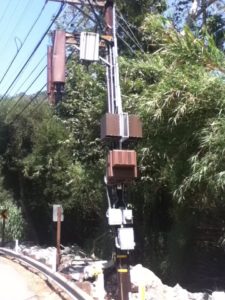
Topanga Canyon, co-located pole with 2 cells (antennas) at top left, with radio boxes at midpole. Very ugly AND dangerous.
IMPORTANT: Contact your San Diego County Supervisor to let him/her know how you feel about their unanimous vote to drench the County in microwave and millimeter microwave radiation when they admitted it would have health effects during the meeting, and were told it was unsafe and could make homes virtually unsellable if a small cell is placed in front of or near a home. For shame.
Read a letter on the dangers of 5G sent to the BOS from local UCSD world-renowned researcher, Dr. Beatrice Golomb.
See what the County of Marin did – held a 5G workshop to hear from their constituents, then Marin County passed a protective ordinance.
Watch the August 7th Board of Supervisors meeting here and see what you think! Agenda Item 6, Wireless Small Cell Ordinance, begins at 20:45.
| Board of Supervisors Meeting | Aug 7, 2019 | 02h 29m | Approved | Video |
Associated documents [note: downloaded from County website in August/Sept 2019]:
1. cover letter staff
22. Attach G Comm Planning Groups Corresp
public communications sb statement 10
Verizon letter Aug. 6 2019 to SD County BOS
Final SD County SCW Ordinance Adopted Signed 8.7.19
Minute Order (description of amendments voted on, for approval of staff recommendations):
Minute Order Aug. 7.2019
Expanded Minute Order of Aug. 7, 2019 (with Agenda)
San Diego County Small Cell Wireless Ordinance as Adopted and Signed, Aug. 7th, 2019
—————————————
County Supervisors OK 5G Ordinance But Vent Frustration At FCC
Thursday, August 8, 2019
By City News Service
(An article with several errors but one which gives the flavor of the meeting)
——————–
Small Cell Ordinance Ruffles Feathers in San Diego County
A vote to adopt an ordinance to comply with federal 5G rules was met with frustration from supervisors, industry and the public. Among other things, the county will require the submission of annual radio frequency reports.


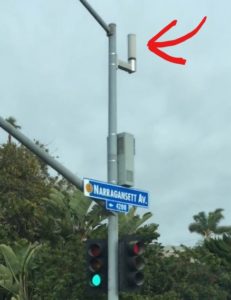
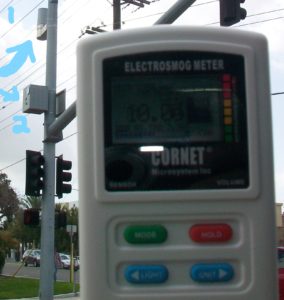
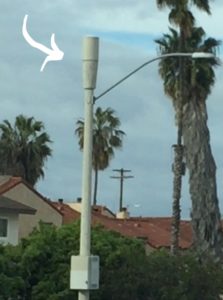
Comments are closed.